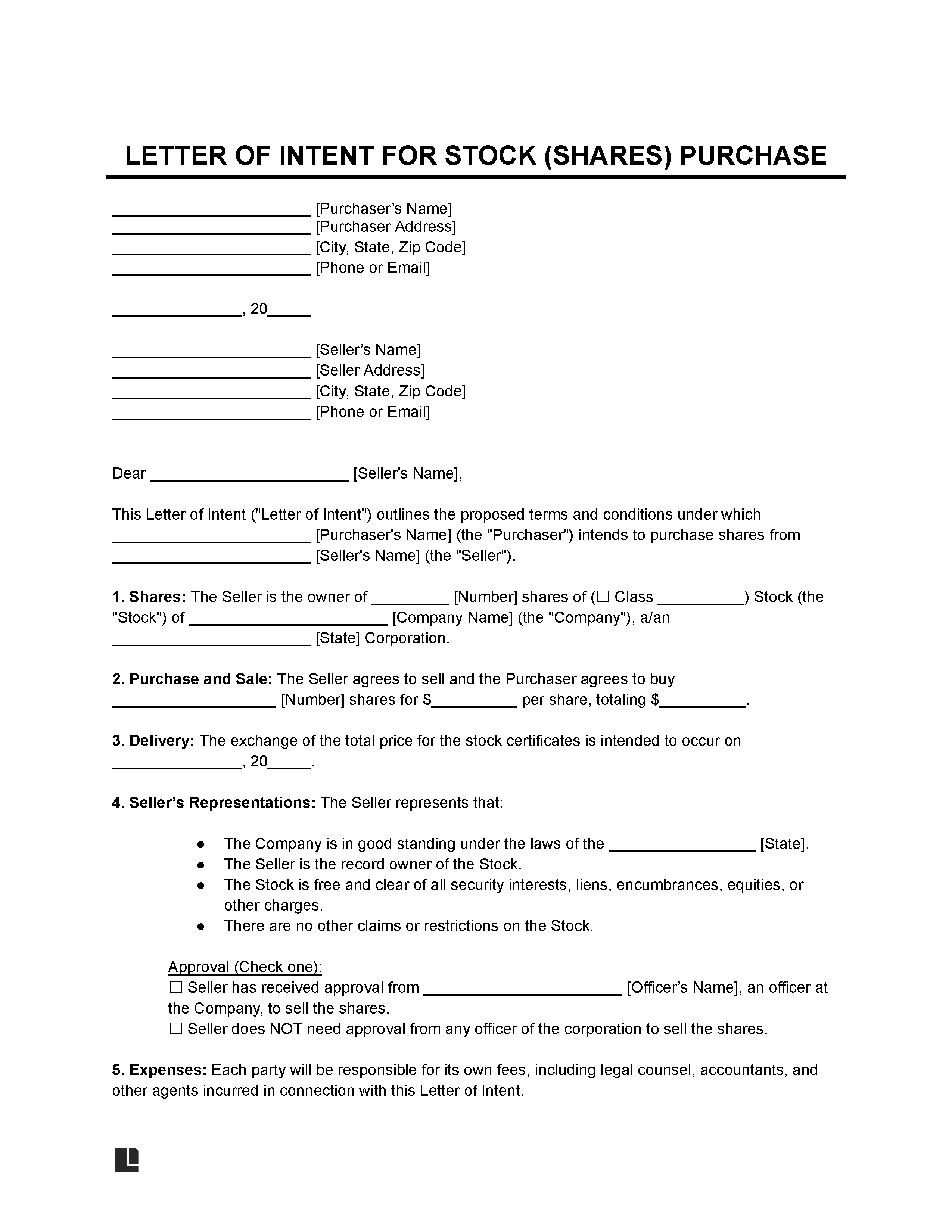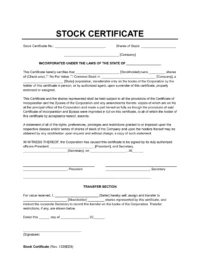A letter of intent to purchase stock is a written communication from a buyer (whether an individual or entity) relaying their intention to buy a company’s stock shares. It’s a precursory offer stating the intention to purchase a limited number of shares at a specific price. Neither party is bound to the terms in this letter.
Supplementary Form
After initial discussions and negotiations, you can finalize a stock purchase plan with a stock purchase agreement. Unlike a letter of intent to purchase stock, a stock purchase agreement is legally binding.
What Are Stock Shares?
Stock shares are ownership units in a company. A company sells stock shares to let individuals or other entities own a small portion of their company. The company gets access to funding, and the buyer gets to enjoy a portion of the financial success that the company experiences.
What to Include in a Letter of Intent to Purchase Stock
Here are the essential elements to include in a letter of intent to purchase stock:
Buyer’s Information
The buyer should identify themselves as the party looking to purchase stock. They can include their individual or company name and address at the beginning of the document and list their contact information.
Seller’s Information
The letter should include the name and address of the company selling the stock. It should also detail the company’s contact information for reference.
Stock Price
Record the desired purchase price for each stock share or the total purchase price for the transaction. It may be the current market price or limit price:
- Market Price: The buyer can indicate that they intend to buy the shares for the market price when the parties execute the purchase agreement. This price preference allows for more flexibility.
- Limit Price: The buyer can also state that they intend to buy the shares for a specific limit price. While less flexible, this approach lets the buyer establish a maximum price they’re willing to pay. It may be less than the current market price, which may let them secure a better deal if they’re willing to wait.
Because of the nonbinding nature of this letter, you can use it as a starting point for price negotiations.
Stock Quantity
Propose the number of stock shares you want to purchase. If you’re not sure of the exact amount, you can put an estimated number and later finalize the exact quantity in your stock share purchase agreement.
Stock Type
Indicate the type of stock you want to purchase. Companies have varying ways of dividing their stock shares into classes, so you should be aware of how the seller classifies their shares.
Some common classifications you may see include the following:
| Aspect | Preferred Shares | Common Shares | Executive Shares |
|---|---|---|---|
| Voting Rights | No | Yes (nonpriority) | Yes (priority) |
| Dividend Payments | Regular dividend payments | Regular dividend payments | Regular dividend payments |
| Other Rights | n/a | Access to corporate assets (nonpriority) | Access to corporate assets (priority) |
What Is Outstanding Capital Stock?
Outstanding capital stock is the stock that shareholders own. If a company has 500,000 outstanding shares and an investor buys 100,000 newly issued shares, the company’s total outstanding capital stock increases to 600,000 shares.
Clarification of Intent
Clarify that this letter only outlines your intent to purchase. While the letter may lead to a definitive agreement later, it doesn’t hold either party accountable.
Confidentiality and Exclusivity
Include any confidentiality clauses, ensuring that sensitive information regarding the potential transaction remains confidential. You can also record an exclusivity clause if desired, ensuring that the buyer and seller won’t partake in negotiations with other parties while they’re working out the details of a stock purchase.
Due Diligence
Explain any reasonable efforts either party must make for the buyer to consider the transaction further and eventually close the deal.
Desired Timeline
Explain the desired timeline for finalizing the eventual transaction. Include a closing date by which you’d like both the buyer and the seller to sign a definitive sales agreement.
Benefits of a LOI to Purchase Stock
Here are some key benefits of a letter of intent to purchase stock:
- Clarifies Intentions: It clarifies the buyer’s intention to purchase stock eventually but doesn’t confirm the arrangement, allowing for flexibility.
- Creates a Framework: While neither party has legal obligations in the letter of intent, it creates a framework for the formal agreement later on.
- Initiates Negotiations: The buyer and seller can refer to the letter when initiating good-faith negotiations.
- Confirms Seriousness: The letter assures the seller that the buyer is serious about the proposed transaction.
Letter of Intent to Purchase Stock Sample
Download a letter of intent to purchase stock template in PDF or Word format below:

Stock-Related Documents
Stock Certificate
A company issues a stock certificate as proof of ownership once an individual purchases stock.
